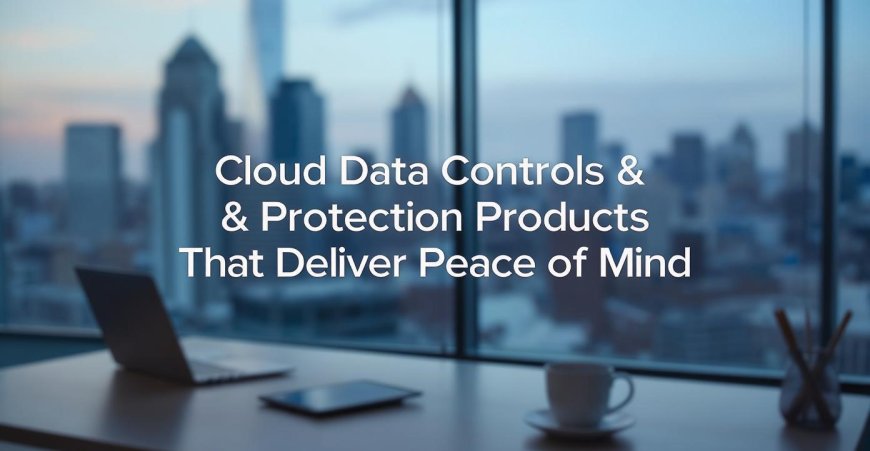Cloud Data Controls & Protection Products That Deliver Peace of Mind
In the age of digital acceleration, enterprises are shifting data and operations to the cloud at an unprecedented pace. But with this shift comes heightened risk. Cloud breaches, data loss, misconfigurations, and regulatory non-compliance can cripple businesses. To counteract these risks, organizations must adopt a modern cloud security posture. This begins with understanding common cloud data controls & Protection products– and how to deploy them today.

In the age of digital acceleration, enterprises are shifting data and operations to the cloud at an unprecedented pace. But with this shift comes heightened risk. Cloud breaches, data loss, misconfigurations, and regulatory non-compliance can cripple businesses. To counteract these risks, organizations must adopt a modern cloud security posture. This begins with understanding common cloud data controls &Protection products and how to deploy them today.
Deploying effective cloud data security mechanisms is no longer optional. Enterprises must proactively implement these tools to secure sensitive data, maintain customer trust, and meet compliance mandates. In this blog, well explore common tools, their use cases, and actionable deployment strategies to safeguard your cloud ecosystem.
Why Cloud Data Protection Matters More Than Ever
Organizations that once relied on traditional on-premises systems now operate in hybrid or fully cloud-based environments. While cloud infrastructure offers scalability and agility, it also opens up vulnerabilities. Cybercriminals exploit misconfigurations, weak access controls, and unsecured APIs to gain access to sensitive business information.
That's why understanding common cloud data controls & protection products and how to deploy them today is critical for every CIO, CISO, and IT leader. These tools are designed to help detect, prevent, and respond to threats in real time while keeping businesses compliant and operational.
Overview of Common Cloud Data Controls & Protection Products
Lets explore the top cloud security categories and products that enterprises are using today.
1. Data Loss Prevention (DLP) Tools
DLP solutions prevent unauthorized access and sharing of confidential data. These tools monitor data in motion, at rest, and in use, applying policies to detect sensitive content like PII, PCI, and IP.
Popular tools:
Microsoft Purview DLP
Symantec DLP
Forcepoint DLP
2. Cloud Access Security Brokers (CASBs)
CASBs bridge the gap between cloud service usage and enterprise security policies. These tools provide visibility into SaaS applications, enforce governance, and protect against risky shadow IT activities.
Popular tools:
Microsoft Defender for Cloud Apps
Netskope
McAfee MVISION Cloud
3. Identity and Access Management (IAM)
IAM ensures that only authorized users can access specific cloud resources. It enforces strong authentication, role-based access control (RBAC), and multi-factor authentication (MFA).
Top solutions:
Okta
Ping Identity
AWS IAM
4. Encryption & Key Management Services
Encryption protects data by converting it into unreadable formats, while key management ensures proper handling of cryptographic keys across platforms.
Tools include:
AWS KMS
Azure Key Vault
Google Cloud KMS
5. Cloud Security Posture Management (CSPM)
CSPM tools continuously monitor for misconfigurations, non-compliance, and security risks across cloud environments.
Leading CSPM products:
Prisma Cloud by Palo Alto
Wiz
Orca Security
How to Deploy Common Cloud Data Controls & Protection Products Today
Deploying these tools successfully involves more than simply purchasing licenses. Here's a strategic approach to implementing common cloud data controls & protection products and how to deploy them today.
Step 1: Assess Your Cloud Risk Landscape
Start by identifying where your sensitive data resideswhether in SaaS apps, cloud storage buckets, or virtual machines. Map out who has access, how data flows, and what controls are already in place.
Step 2: Define a Cloud Data Protection Policy
Develop a comprehensive policy covering access controls, data sharing protocols, encryption standards, and acceptable usage. Make sure this policy aligns with industry standards such as ISO 27001, NIST, and CIS benchmarks.
Step 3: Deploy DLP to Protect Sensitive Data
Begin with DLP implementation for data in email, collaboration tools, and storage services. Define custom policies to detect specific content types like health records or credit card numbers. Configure alerts and automatic quarantines for policy violations.
Step 4: Integrate CASBs for Visibility & Governance
Use CASBs to gain insights into sanctioned and unsanctioned cloud apps. Set rules to block risky apps, enable secure access, and encrypt uploads/downloads in real-time. Integrate CASBs with SIEM tools for extended threat visibility.
Step 5: Enforce IAM and Zero Trust Architecture
Adopt a Zero Trust approach by verifying every access attempt regardless of source. Set up role-based access with least privilege principles. Ensure MFA is enabled across all critical accounts, and integrate with your IAM provider for centralized control.
Step 6: Apply Consistent Encryption & Key Management
Use native cloud encryption tools to secure storage services and databases. Rotate encryption keys regularly and store them securely using centralized key management systems. Avoid hardcoding credentials in source code.
Step 7: Monitor Posture with CSPM Tools
CSPM solutions help automate compliance by scanning for vulnerabilities and misconfigurations. Integrate them with CI/CD pipelines to identify and fix issues before deployment. Set up daily reporting to stay audit-ready.
Step 8: Conduct Regular Security Training
Train your staff to understand cloud security policies and identify phishing attacks. Empower DevOps teams with secure coding practices. Make cloud security part of your organizational culture.
Challenges in Cloud Data Control Deployments
While the benefits of cloud security tools are undeniable, organizations often face challenges in implementing them effectively.
1. Multi-cloud Complexity
Many organizations use services from AWS, Azure, and GCP simultaneously. Each platform has different tools and configurations, making unified security a challenge.
2. Configuration Errors
Misconfigurations are a leading cause of cloud data breaches. Without automation and continuous monitoring, its easy to overlook risky settings.
3. Lack of Skilled Staff
Deploying common cloud data controls & protection products and how to deploy them today requires cloud security expertise. However, the demand for skilled professionals often outpaces supply.
4. Budget Constraints
Licensing top-tier security products can be expensive. Balancing protection and cost-efficiency is a constant struggle for many IT departments.
To overcome these challenges, businesses should consider managed service providers or cloud security consultants who specialize in scalable deployments.
Emerging Trends in Cloud Data Protection
The future of cloud data security is dynamic. As threats evolve, so do defense strategies. Here are a few trends shaping the industry:
AI-Driven Threat Detection
Artificial intelligence enables real-time anomaly detection, behavior analytics, and predictive threat modeling. Tools like Microsoft Sentinel and IBM QRadar are adopting AI at scale.
Automation and Remediation
Modern CSPMs offer auto-remediation scripts that fix misconfigurations instantly, reducing human error and time-to-response.
Compliance-as-Code
Organizations are embedding compliance checks into CI/CD pipelines, making governance an automated part of development lifecycles.
Decentralized Identity (DID)
Decentralized identity models, powered by blockchain, are emerging as a secure and privacy-centric way to manage digital identities.
Use Cases from Industry Leaders
Finance: A multinational bank deployed DLP and CASB tools across its cloud email and document platforms to protect customer data and prevent unauthorized file sharing.
Healthcare: A hospital network used IAM and CSPM to enforce HIPAA compliance across its hybrid infrastructure.
Retail: A global e-commerce company implemented encryption and key management tools to secure customer purchase history and payment data.
These real-world examples underscore the effectiveness of deploying common cloud data controls & protection products and how to deploy them today in diverse industries.
Bizinfopro: Your Trusted Cloud Security Partner
At Bizinfopro, we empower organizations with insights and solutions to strengthen their cloud data security. Whether you're a small business or a large enterprise, our expert-led webinars and deployment strategies guide you through each step of securing your cloud infrastructure.
Read Full Article : https://bizinfopro.com/webinars/common-cloud-data-controls-protection-products-and-how-to-deploy-them-today/
About Us : BizInfoPro is a modern business publication designed to inform, inspire, and empower decision-makers, entrepreneurs, and forward-thinking professionals. With a focus on practical insights and in?depth analysis, it explores the evolving landscape of global businesscovering emerging markets, industry innovations, strategic growth opportunities, and actionable content that supports smarter decision?making.

































